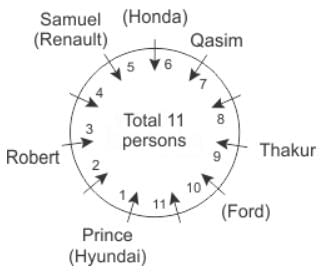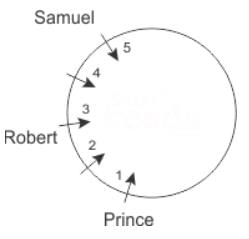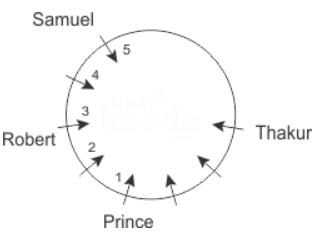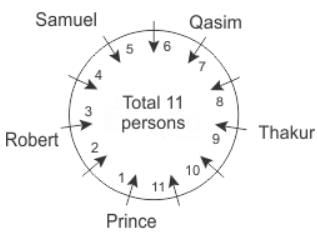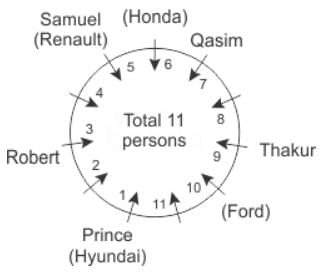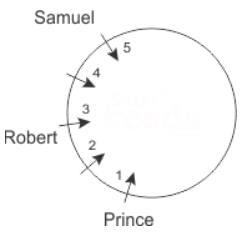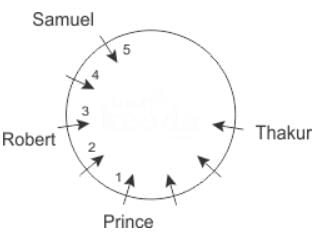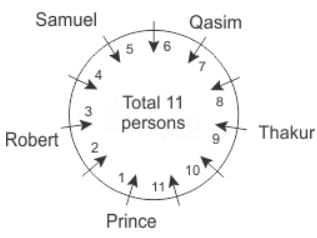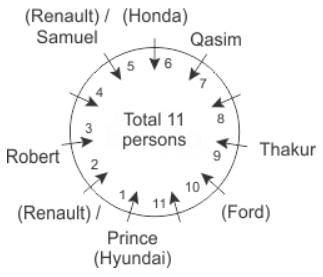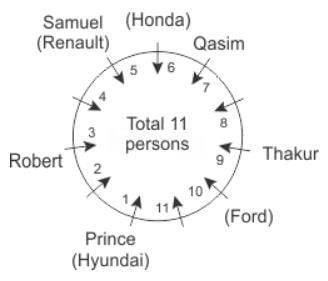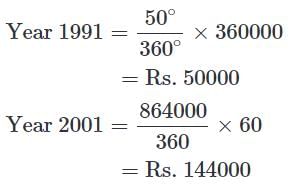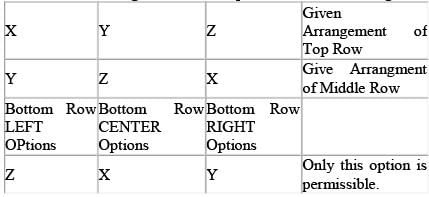EPFO Assistant Prelims Mock Test - 9 - Bank Exams MCQ
30 Questions MCQ Test - EPFO Assistant Prelims Mock Test - 9
Directions: In the following questions two statements are followed by two conclusions. You have to mark the appropriate answer as per the information given.
Statement : R > M ≥ T ≤ Q = S
Conclusions : I. R > Q, II. Q ≥ M
Conclusions : I. R > Q, II. Q ≥ M
Directions to Solve
In each of the following questions find out the alternative which will replace the question mark.
Question -
10 : 99 :: 9 : ?
Directions to Solve
In each of the following questions find out the alternative which will replace the question mark.
Question -
8 : 24 :: ? : 32
Directions: Read the given information carefully and answer the questions given beside:
Certain number of persons are sitting around a circular table and facing towards the center of the table. Some of them own different cars. No two persons have same car.
Three persons are sitting between Thakur and the one, who owns Renault. Two persons are sitting between Thakur and Prince. Robert is sitting second to the left of Prince. Samuel is sitting second to the left of Robert. Samuel and Thakur are not the immediate neighbors. Qasim is sitting second to the right of Thakur. The one, who owns Ford, is sitting third to the left of Qasim. The one, who owns Hyundai, is sitting second to the left of the one, who owns Ford. Three persons are not sitting between the one, who owns Renault and the one, who owns Honda, when counted from the right of the one, who owns Honda. The one, who sits immediate left of Samuel, owns Honda. Number of persons sitting between Qasim and Prince, when counted from right of Prince is four times as the number of persons sitting between Samuel and Qasim, when counted from left of Samuel.
Q. Who owns Ford car?
Directions: Read the given information carefully and answer the questions given beside:
Certain number of persons are sitting around a circular table and facing towards the center of the table. Some of them own different cars. No two persons have same car.
Three persons are sitting between Thakur and the one, who owns Renault. Two persons are sitting between Thakur and Prince. Robert is sitting second to the left of Prince. Samuel is sitting second to the left of Robert. Samuel and Thakur are not the immediate neighbors. Qasim is sitting second to the right of Thakur. The one, who owns Ford, is sitting third to the left of Qasim. The one, who owns Hyundai, is sitting second to the left of the one, who owns Ford. Three persons are not sitting between the one, who owns Renault and the one, who owns Honda, when counted from the right of the one, who owns Honda. The one, who sits immediate left of Samuel, owns Honda. Number of persons sitting between Qasim and Prince, when counted from right of Prince is four times as the number of persons sitting between Samuel and Qasim, when counted from left of Samuel.
Q. Who sits third to the right of the one, who owns Honda car?
Directions to the following questions, Read the given information carefully into answer the questions that follows.
- There is a family of six members.
- Members are A, B, C, D, E, and F.
- A and B are married couple, B being the female member.
- B is the daughter-in-law of F.
- D is the only son of C.
- E is the sister of D.
- F's husband is dead.
- C is A's brother.
Q. How is E related to C ?
Directions to the following questions, Read the given information carefully into answer the questions that follows.
- There is a family of six members.
- Members are A, B, C, D, E, and F.
- A and B are married couple, B being the female member.
- B is the daughter-in-law of F.
- D is the only son of C.
- E is the sister of D.
- F's husband is dead.
- C is A's brother.
Q. How many females are there in the family ?
Directions to the following questions, Read the given information carefully into answer the questions that follows.
- There is a family of six members.
- Members are A, B, C, D, E, and F.
- A and B are married couple, B being the female member.
- B is the daughter-in-law of F.
- D is the only son of C.
- E is the sister of D.
- F's husband is dead.
- C is A's brother.
Q. How many males are there in the family ?
Statements :
I. In the code language, 'sky is clear' is written as 'de ra fa'.
II. In the same code language, 'make it clear' is written as 'de ga jo'.
Q: What is the code for 'sky' in the code language ?
Directions: Study the following information carefully and answer the given questions.
The distance between N and P is 50m and that between Q and R is 40m. Q is to the west of R, which is to the east of N at a distance of 70m. P is to the west or northwest or north or Q.
Q. In which direction is R with respect to P?
Direction: In each question below is given a statement followed by two conclusions numbered I and II. You have to assume everything in the statement to be true, then consider the two conclusions together and decide which of them logically follows beyond a reasonable doubt from the information given in the statement.
Statements: Recent trends also indicate that the number of child migrants in large cities is increasing. These children leave their families to join the ranks of urban poor doing odd jobs in markets, workshops, hotels or in service sectors.
Conclusions:
- Migration to big cities should be checked.
- The plight of poor children should be thoroughly studied.
Direction: In each question below is given a statement followed by two conclusions numbered I and II. You have to assume everything in the statement to be true, then consider the two conclusions together and decide which of them logically follows beyond a reasonable doubt from the information given in the statement.
Statements: The percentage of the national income shared by the top 10 per cent of households in India is 35.
Conclusions:
- When an economy grows fast, concentration of wealth in certain pockets of population takes place.
- The national income is unevenly distributed in India.
Direction: In each question below is given a statement followed by two conclusions numbered I and II. You have to assume everything in the statement to be true, then consider the two conclusions together and decide which of them logically follows beyond a reasonable doubt from the information given in the statement.
Statements: Although we have rating agencies like Crisil, ICRA, there is demand to have a separate rating agency for IT companies to protect investors.
Conclusions:
- Assessment of financial worth of IT companies calls for separate set of skills, insight and competencies.
- Now the investors investing in IT companies will get protection of their investment.
Direction : Study the following question carefully and choose the right answer.
Q: If in a certain code, CORPORATIONS, is written as PROCTAROSNOI, then how is JUDICIAL written in that code?
A can do a piece of work in 20 days. He works at it for 5 days and then B finishes it in 10 moredays. In how many days will A and B together finish the work?
A vendor sells 50 percent of apples he had and throws away 20 percent of the remainder. Next day he sells 60 percent of the remainder and throws away the rest. What percent of his apples does the vendor throw?
Directions: Study the given table carefully and answer the question that follow:
Number of candidates appeared and qualified for a test (in hundreds) in 6 different years from 5 different zones.
Note: Here App. means Appeared and Qual. Means qualified.

Q. From which zone was the total number of candidates who qualified the test, the second highest in the year?
Directions: Pie-charts show the expenses on various heads show the expenses on various heads in construction of a house. Study the pie-chart.
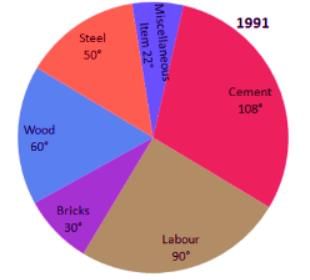

Q. What percentage of the total amount is being spent on cement in 1991?
Directions: Pie-charts show the expenses on various heads show the expenses on various heads in construction of a house. Study the pie-chart.

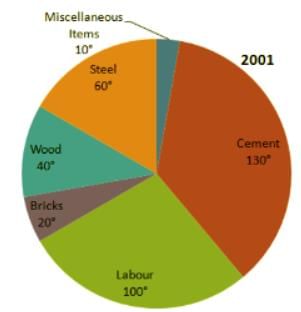
Q. If the total cost of constructing the house is Rs. 3,60,000 in 1991 and Rs. 8,64,000 in 2001, what is the amount spent on Steel in 1991 and 2001?
How many different combinations of outcomes can you make by rolling three standard (6-sided) dice if the order of the dice does not matter?
A certain league has four divisions. The respective divisions had 9, 10, 11, and 12 teams qualify for the playoffs. Each division held its own double-elimination tournament -- where a team is eliminated from the tournament upon losing two games -- in order to determine its champion. The four division champions then played in a single-elimination tournament -- where a team is eliminated upon losing one game -- in order to determine the overall league champion. Assuming that there were no ties and no forfeits, what is the maximum number of games that could have been played in order to determine the overall league champion?
You have a bag of 9 letters: 3 Xs, 3 Ys, and 3 Zs. You are given a box divided into 3 rows and 3 columns for a total of 9 areas. How many different ways can you place one letter into each area such that there are no rows or columns with 2 or more of the same letter?

Six litre of milk was taken out from a vessel and is then filled with water. This operation is performed two more times. The ratio of the quantity of milk now left in vessel to that of the water is 8 : 27. How much is the quantity of the milk contained by the vessel originally?
The website, which does not / accept advertisement and is funded / entirely by donations, describes itself / as the fifth most popular website on the planet.
The Moon may be the best place / to look for aliens as their / footprints on their surface would / last far longer than radio signals.
Directions: Identify the words that are similar in meaning to the phrase in underline. If none of option conveys the correct meaning, mark (E) as your answer. The options do not necessarily need to be grammatically correct.
The Chinese media in a backhanded compliment hailed the ISRO launching 104 satellites but not before reminding India it had the world's largest number of poor and its space technology lagged China by miles.
The national unity of a free people
P: to make it impracticable
Q: for there to be an arbitrary administration
R: depends upon a sufficiently even balance of political power
S: against a revolutionary opposition that is irreconcilably opposed to it
The Proper sequence should be:
The grocer
P: did not listen to the protests of customer
Q: who was in the habit of weighing less
R: whom he had cheated
S: with great audacity
The Proper sequence should be:
Directions: The following question has two blanks. In each blank a preposition has been omitted. Choose the set of prepositions for each blank that best fits in the context of the sentence.
This idea is also the explanation of his government’s policy ________ Jammu and Kashmir, as reflected _________ his own pronouncements.




